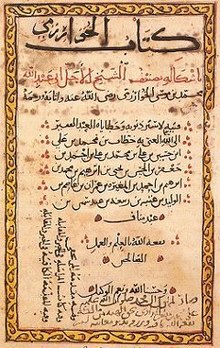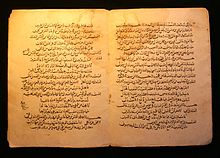Saylor.org's Ancient Civilizations of the World/Abbasid Society and Culture
Culture: An Islamic Golden Age
[edit | edit source]The fifth caliph of the Abbasid dynasty, Harun al-Rashid (r. 786-809) became one of the most generous patrons of the arts and sciences in history. The sheer size of the caliphate meant that scholars and artists could easily draw inspiration and expand upon the works of other, older civilizations: Persian, Egyptian, Greek, Roman, Byzantine, Indian, and even Chinese. Successors to the throne continued the wise policies of patronage. Harun's son, al-Ma'mun (r. 813-833) founded the Bayt al-Hikma, House of Wisdom, in Baghdad. While the House of Wisdom was a library, it also served as a proto-university where scholars could translate the works of foreign knowledge into arabic.
It was at the House of Wisdom that Indian numerals (the numeric system we use today, as opposed to, say, Roman numerals) became fully integrated into mathematical equations. Mathematics was revolutionized by the concepts of algebra and algorithms (both arabic terms). Greek philosophy was synthesized with Islamic thought, geometry and optics were enhanced and utilized in the study of astronomy. Even the concept of the "scientific method" was said to have emerged during this era of Islamic rule.
Even more practical to the daily life of those in the caliphate were the innovations in agricultural production. New forms of irrigation, mills and turbines reduced some of the burden of back-breaking labor, however slavery persisted in the Islamic world. An agricultural exchange brought rice, cotton, and sugar from India, citrus fruits from China, and sorghum from Africa. In time, trade with Europeans would bring these goods to the Western world, as well.
Art of the Abbasid Period
[edit | edit source]
Artists in the capital city of Baghdad and its important neighbor to the north, Samarra, set the trend for art styles in the rest of the Islamic world. Unfortunately for historians, virtually nothing remains of this Abbasid artistic creativity in the city Baghdad, elevating Samarra's significance even more. In Samara, a new technique in the decorative arts took off: a beveled style of carving surfaces with repetitive abstract designs or vegetal patterns. In the west, it would become known as an 'arabesque' and would be utilized in diverse media ranging from wood to stone, metal to pottery. In their pottery, artists of Samarra were noted for extensive colors through the innovation of luster painting. Luster painting was perhaps the greatest technical advance in the arts of the age and spread rapidly through the Islamic world.
Science
[edit | edit source]The reigns of Harun al-Rashid (786–809) and his successors fostered an age of great intellectual achievement. In large part, this was the result of the schismatic forces that had undermined the Umayyad regime, which relied on the assertion of the superiority of Arab culture as part of its claim to legitimacy, and the Abbasids' welcoming of support from non-Arab Muslims. It is well established that the Abbasid caliphs modeled their administration on that of the Sassanids. Harun al-Rashid's son, Al-Ma'mun, is even quoted as saying:
- "The Persians ruled for a thousand years and did not need us Arabs even for a day. We have been ruling them for one or two centuries and cannot do without them for an hour."
A number of medieval thinkers and scientists living under Islamic rule played a role in transmitting Islamic science to the Christian West. They contributed to making Aristotle known in Christian Europe[citation needed]. In addition, the period saw the recovery of much of the Alexandrian mathematical, geometric and astronomical knowledge, such as that of Euclid and Claudius Ptolemy. These recovered mathematical methods were later enhanced and developed by other Islamic scholars, notably by Persian scientists Al-Biruni and Abu Nasr Mansur.

Algebra was significantly developed by Persian scientist Muhammad ibn Mūsā al-Khwārizmī during this time in his landmark text, Kitab al-Jabr wa-l-Muqabala, from which the term algebra is derived. He is thus considered to be the father of algebra by some, although the Greek mathematician Diophantus has also been given this title. The terms algorism and algorithm are derived from the name of al-Khwarizmi, who was also responsible for introducing the Arabic numerals and Hindu-Arabic numeral system beyond the Indian subcontinent.
Ibn al-Haytham (Alhazen) developed an early scientific method in his Book of Optics (1021). The most important development of the scientific method was the use of experiments to distinguish between competing scientific theories set within a generally empirical orientation, which began among Muslim scientists. Ibn al-Haytham's empirical proof of the intromission theory of light (that is, that light rays entered the eyes rather than being emitted by them) was particularly important. Author Bradley Steffens described Ibn al-Haytham as the "first scientist" for his development of scientific method.
Medicine in medieval Islam was an area of science that advanced particularly during the Abbasids' reign. During the ninth century, Baghdad contained over 800 doctors, and great discoveries in the understanding of anatomy and diseases were made. The clinical distinction between measles and smallpox was described during this time. Famous Persian scientist Ibn Sina (known to the West as Avicenna) produced treatises and works that summarized the vast amount of knowledge that scientists had accumulated, and was very influential through his encyclopedias, The Canon of Medicine and The Book of Healing. The work of him and many others directly influenced the research of European scientists during the Renaissance.

Astronomy in medieval Islam was advanced by Al-Battani, who improved the precision of the measurement of the precession of the Earth's axis. The corrections made to the geocentric model by al-Battani, Averroes, Nasir al-Din al-Tusi, Mo'ayyeduddin Urdi and Ibn al-Shatir were later incorporated into the Copernican heliocentric model. The astrolabe, though originally developed by the Greeks, was developed further by Islamic astronomers and engineers, and subsequently brought to medieval Europe.
Muslim alchemists influenced medieval European alchemists, particularly the writings attributed to Jābir ibn Hayyān. A number of chemical processes such as distillation techniques were developed in the Muslim world and then spread to Europe.
Literature
[edit | edit source]
The best known fiction from the Islamic world was The Book of One Thousand and One Nights (Arabian Nights). The original concept is derived from pre-Islamic Iranian (Persian) prototype with reliance on Indian elements. It also includes stories from the rest of the Middle-Eastern and North African nations. The epic took form in the 10th century and reached its final form by the 14th century; the number and type of tales have varied from one manuscript to another. All Arabian fantasy tales were often called "Arabian Nights" when translated into English, regardless of whether they appeared in The Book of One Thousand and One Nights. This epic has been influential in the West since it was translated in the 18th century, first by Antoine Galland. Many imitations were written, especially in France. Various characters from this epic have themselves become cultural icons in Western culture, such as Aladdin, Sinbad and Ali Baba.
A famous example of Arabic poetry on romance was Layla and Majnun, which further developed mainly by Iranian, Azerbaijani and other poets in Persian, Azerbaijani, Turkish, and other Turk languages dating back to the Umayyad era in the 7th century. It is a tragic story of undying love much like the later Romeo and Juliet.
Arabic poetry reached its greatest heights in the Abbasid era, especially before the loss of central authority and the rise of the Persianate dynasties. Writers like Abu Tammam and Abu Nuwas were closely connected to the caliphal court in Baghdad during the early 9th century, while others such as al-Mutanabbi received their patronage from regional courts.
Technology
[edit | edit source]
In technology, the Muslim world adopted papermaking from China. The use of paper spread from China into the Muslim world in the eighth century CE, arriving in Spain (and then the rest of Europe) in the 10th century CE. It was easier to manufacture than parchment, less likely to crack than papyrus, and could absorb ink, making it ideal for making records and making copies of the Koran. "Islamic paper makers devised assembly-line methods of hand-copying manuscripts to turn out editions far larger than any available in Europe for centuries." It was from Islam that the rest of the world learned to make paper from linen. The knowledge of gunpowder was also transmitted from China via Islamic countries, where the formulas for pure potassium nitrate and an explosive gunpowder effect were first developed.
Advances were made in irrigation and farming, using new technology such as the windmill. Crops such as almonds and citrus fruit were brought to Europe through al-Andalus, and sugar cultivation was gradually adopted by the Europeans. Apart from the Nile, Tigris and Euphrates, navigable rivers were uncommon, so transport by sea was very important. Navigational sciences were highly developed, making use of a rudimentary sextant (known as a kamal). When combined with detailed maps of the period, sailors were able to sail across oceans rather than skirt along the coast. Muslim sailors were also responsible for reintroducing large three masted merchant vessels to the Mediterranean. The name caravel may derive from an earlier Arab boat known as the qārib. Arab merchants dominated trade in the Indian Ocean until the arrival of the Portuguese in the 16th century. Hormuz was an important center for this trade. There was also a dense network of trade routes in the Mediterranean, along which Muslim countries traded with each other and with European powers such as Venice, Genoa and Catalonia. The Silk Road crossing Central Asia passed through Muslim states between China and Europe. Muslim engineers in the Islamic world made a number of innovative industrial uses of hydropower, and early industrial uses of tidal power, wind power, and petroleum (notably by distillation into kerosene). The industrial uses of watermills in the Islamic world date back to the 7th century, while horizontal-wheeled and vertical-wheeled water mills were both in widespread use since at least the 9th century. By the time of the Crusades, every province throughout the Islamic world had mills in operation, from al-Andalus and North Africa to the Middle East and Central Asia. These mills performed a variety of agricultural and industrial tasks. Muslim engineers also developed machines (such as pumps) incorporating crankshafts, employed gears in mills and water-raising machines, and used dams to provide additional power to watermills and water-raising machines. Such advances made it possible for many industrial tasks that were previously driven by manual labour in ancient times to be mechanized and driven by machinery instead in the medieval Islamic world. It has been argued that the industrial use of waterpower had spread from Islamic to Christian Spain, where fulling mills, paper mills, and forge mills were recorded for the first time in Catalonia.
A number of industries were generated during the Arab Agricultural Revolution, including early industries for textiles, sugar, rope-making, matting, silk, and paper. Latin translations of the 12th century passed on knowledge of chemistry and instrument making in particular. The agricultural and handicraft industries also experienced high levels of growth during this period.
Society: Evolution of Islamic Identity
[edit | edit source]While the Abbasids originally gained power by exploiting the social inequalities against non-Arabs in the Umayyad Empire, ironically during Abbasid rule the empire rapidly Arabized. As knowledge was shared in the Arabic language throughout the empire, people of different nationalities and religions began to speak Arabic in their everyday lives. Resources from other languages began to be translated into Arabic, and a unique Islamic identity began to form that fused previous cultures with Arab culture, creating a level of civilization and knowledge that was considered a marvel in Europe.
Attribution
[edit | edit source]"The Abbasid Caliphate" (Wikipedia) http://en.wikipedia.org/wiki/Abbasid_Caliphate